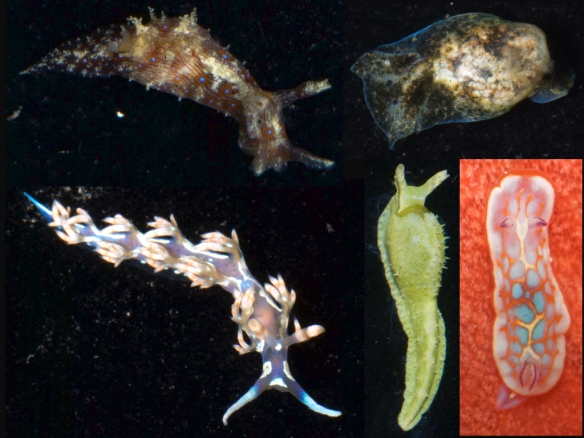UPDATE: If you happen to be interested in more scientific details, you can download a paper detailing all the species we found here.
I recently returned from Panama where I helped teach a workshop on the taxonomy & biology of sea slugs at the Smithsonian Tropical Research Institute’s Bocas del Toro research station. Getting back into the ocean after being stuck at a computer desk or lab bench for 3 years inspired me to bring this blog out of hibernation.
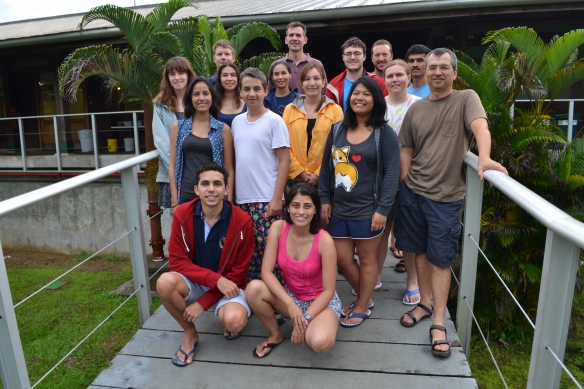
Students from 7 countries gathered at the STRI research station in Bocas del Toro, Panama for a 2-week workshop on the taxonomy and biology of sea slugs.
The workshop was organized by my post-doc advisor at Cal State LA, Patrick Krug, and Cal Poly Pomona professor Ángel Valdés. Participants included 5 students from these two labs in Southern California, plus enthusiastic undergraduate and grad students from Florida, Maryland, Costa Rica, El Salvador, Mexico, Colombia, India, and Brazil – only 13 students but they represented 7 different countries!
Lectures and lab activities relating to the taxonomy and evolution of sea slugs were necessary, but we also spent many hours snorkeling in the shallow waters around Isla Colón, an island off the Caribbean coast of Panama. The island belongs to the Bocas del Toro Province, which borders Costa Rica.

Twice a day for two weeks we went out on a boat to snorkel for sea slugs. Here we are looking extremely safe in our life jackets during one of the few moments the sun came out.
The best way to learn about sea slugs and most other animals is to observe them, so we needed to collect as many as possible – and the numbers suggest we did a decent job. Only 19 different species of sea slugs had been officially documented from the waters surrounding Isla Colón (Collin et al. 2005; pages 689-693). By the time we finished 12 days of collection and observation, we had catalogued nearly 80 distinct species. More than 20 of these have never been formally described, meaning they are entirely new to science! The class is currently working to put together a field guide-type manuscript to list all of the species we found. Much more work is needed to verify and formally describe what we suspect are new species.
Sea slugs are closely related to their more familiar cousins, terrestrial and freshwater snails and slugs. The evolutionary history among all these groups has not yet been fully resolved, but DNA sequence evidence points to an interesting story. The most comprehensive genetic study to date (Kocot et al. 2013) suggests that one lineage of sea snails developed drastically reduced shells (or lost them altogether) in becoming the ancestor of all sea slugs. Then as this ancestor diversified into many species of sea slugs, one of their descendant lineages slowly made the transition to land, evolved a lung, and became the common ancestor of all terrestrial (and freshwater) snails and slugs. DNA sequences from additional genes and/or species could either contradict or further support this interpretation.
Sea slugs themselves are divided into four main groups. The most well-known and biodiverse group is Nudibranchia – these carnivores feed on sponges, cnidarians (jellyfishes, corals, hydroids, etc.), and even other sea slugs. Lacking the protective shells of their snail cousins, most sea slugs use nasty toxins for defense, which they either synthesize or harvest from their prey. This is what facilitates the evolution of their brilliant aposematic coloration.

Two individual slugs of the aeolid species Berghia rissodominguezi crawling on rock.
Photo by Gina Lopez
Along with or as an alternative to chemical toxins, many species of aeolid nudibranchs also possess the remarkable ability to steal nematocysts (stinging cells) from their cnidarian prey without setting off the stinger – the firing of these cells is what causes the pain of a jellyfish sting and the stickiness you feel when you touch an anemone. The slugs store these stinging cells in finger-like projections called cerata, using them for defense against other predators.

Sometimes it seems like the most beautiful slugs don’t look like animals at all – here’s the aeolid Tritonia bayeri.
Photo by Ángel Valdés
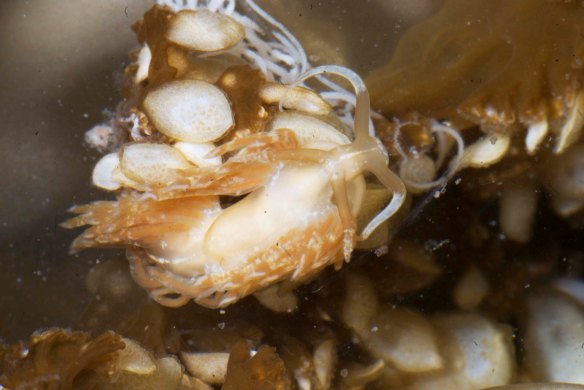
Dondice parguerensis is seen here in its natural habitat, feeding on and receiving protection from the tentacles of an upside down jellyfish, Cassiopea xamachana.
Photo by Ángel Valdés

The bright colors of Dondice occidentalis likely evolved as a warning to predators of the stinging nematocysts stored in its cerata.
Photo by Ángel Valdés
Another group of nudibranchs, the dorids, feeds primarily on sponges and lacks the cerata that are distinctive of aeolids. The “sea bunny” whose photos recently went viral is an example of a dorid. Dorids have an exposed but retractable cluster of gills near their posterior called a branchial plume. This organ is actually what gives rise to the name nudibranch, which is derived from the Latin word for naked and Greek word for gill. Most nudibranchs are relatively small—just a few inches long and in some cases shorter than a centimeter—but one dorid in the Pacific Ocean, the Spanish dancer Hexabranchus sanguineus, can reach lengths of over 40 cm! Click here to see its Caribbean sister species (H. morsomus) display its flappy swimming technique when disturbed.
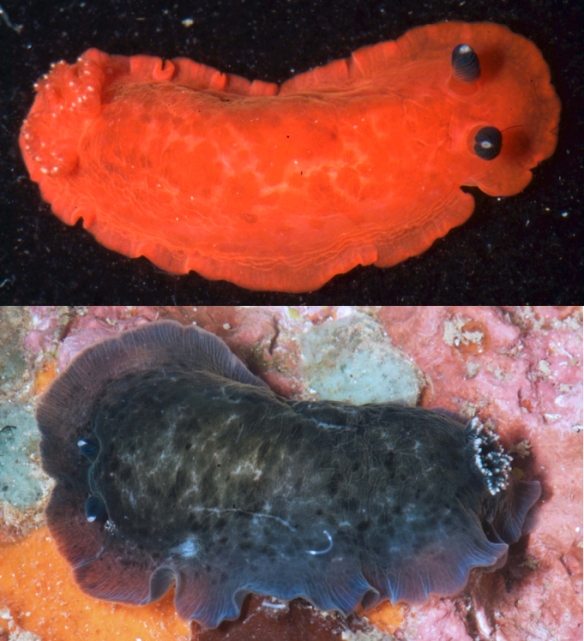
Two different individuals of the same species, Dendrodoris krebsii. As you can see, it’s one of the most variably colored nudibranchs in the world.
Photos by Ángel Valdés
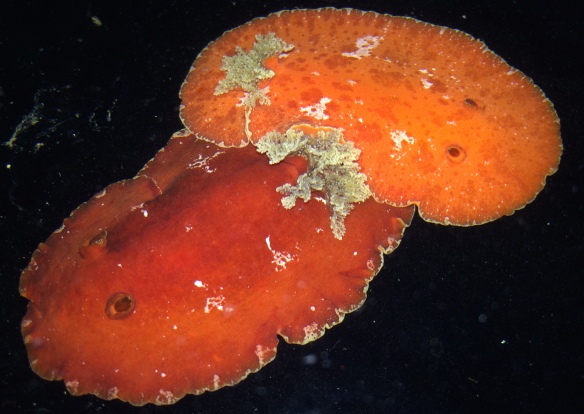
While snorkeling I noticed a spiraled bright orange egg mass on a rock, then found these two Platydoris angustipes underneath.
Photo by Ryan Ellingson

Some dorids look more like an artist’s creation than an animal – Doriprismatica sedna.
Photo by Ángel Valdés
A second group of carnivorous sea slugs is called Cephalaspidea – the headshield slugs and bubble snails. These slugs have a characteristic head shield that is used tosense their surroundings and burrow through the upper surface of sand. Most species have retained the shell of their snail ancestors, though it is dramatically reduced (small and/or thin) and often internal so it fails to provide any meaningful protection. They feed primarily on other sea slugs and various types of marine worms, often swallowing their prey whole and crushing it in a gizzard that contains calcareous plates. They are such voracious predators that some have even been observed cannibalizing other members of the same species.
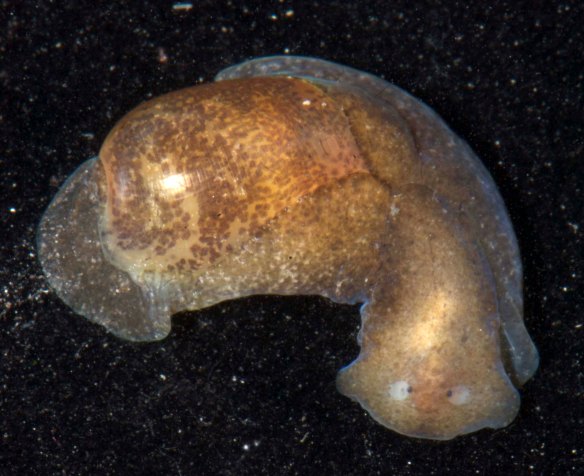
Haminoea elegans is part of a small group commonly called bubble snails because of their delicate shells, but they are more closely related to slugs than snails.
Photo by Ángel Valdés
A third group of slugs is called Aplysiomorpha (or Anaspidea, depending on who you ask), commonly known as sea hares. Sensory structures on the head called rhinophores are a characteristic of nearly all sea slugs, except for cephalaspideans. The name sea hare comes from the large, rolled rhinophores that somewhat resemble rabbit ears. This group contains the largest known slug, the black sea hare Aplysia vaccaria. All sea slugs are hermaphrodites, and sea hares in particular are known to form daisy chain orgies when mating – you’re welcome.

It may just look dirty, but Bursatella leachi is actually covered in fleshy papillae that help it blend in with its surroundings.
Photo by Ángel Valdés
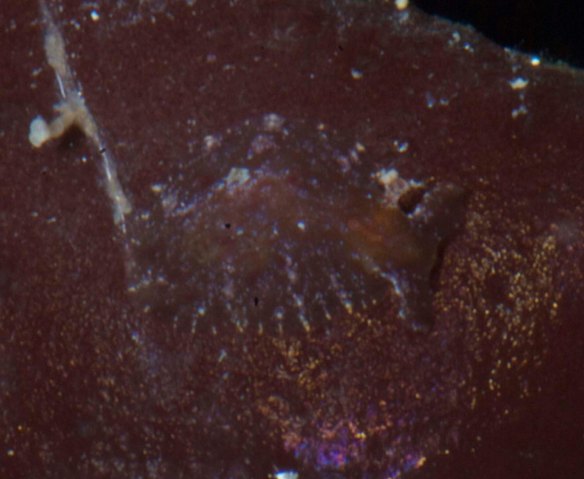
While many slugs are brightly colored to warn predators of their toxicity, others are incredibly cryptic. Here’s an example of Phyllaplysia engeli blending into its surroundings.
Photo by Ángel Valdés

The spotted sea hare Aplysia dactylomela is found in tropical and temperate waters around the world. As with many cosmopolitan species, genetic studies may reveal that what we currently recognize as a single species may be more than one.
Photo by Sabrina Medrano.
The last and arguably most interesting group of slugs is Sacoglossa – the group that happens to be the focus of my current research. Sacoglossans eat algae and are sometimes referred to as sap-sucking sea slugs. This common name comes from the fact that many species feed by poking a hole in an algal filament and sucking out the insides. This works because the algae is siphonaceous; a single filament contains many cells but no cell walls that divide them. This means a slug can use its tooth (called a radula) to puncture an algal filament and then suck out all the nutritious cells. Under a low-powered microscope you can actually watch a slug wrap its mouth around a filament and drain it of its green cells, leaving it empty and transparent.

Elysia crispata is one of the largest and most morphologically variable sacoglossans, and probably the most familiar to divers and hobbyists.
Photos by Ángel Valdés
Not to be outdone by their nematocyst-thieving cousins, many sacoglossans practice kleptoplasty – they steal photosynthetic chloroplasts from their algal food source and store the organelles in their own tissues. These chloroplasts remain functional as slugs use the sun to generate sugars via photosynthesis, allowing them to go weeks or even months without eating food. There is even strong evidence that at least one species has taken photosynthesis genes from algae and incorporated them into its own genome – a remarkable adaptation that allows an animal to make its own food from sunlight, water, and carbon dioxide just like a plant.
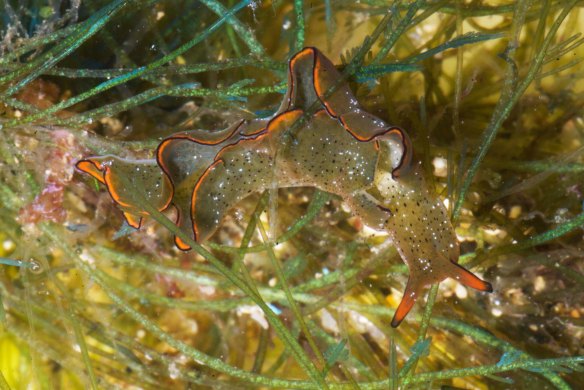
Elysia ornata crawling on some filaments of Bryopsis green algae, on which it feeds.
Photo by Ángel Valdés
It was great to meet students from so many different countries and work together to document many more species of sea slugs than had ever been catalogued from the waters around Bocas del Toro. Even though we primarily hunted for sea slugs, it’s hard not to marvel at all the other marine life you come across when spending so much time in tropical reef habitats. Below are some pics worth seeing even though they’re not slugs:

The sea cucumber Ocnus suspectus inserts its tentacles into its mouth one at a time, scraping off bits of food as it pulls each tentacle back out. Click here to see this behavior in action.
Photo and video by Ryan Ellingson
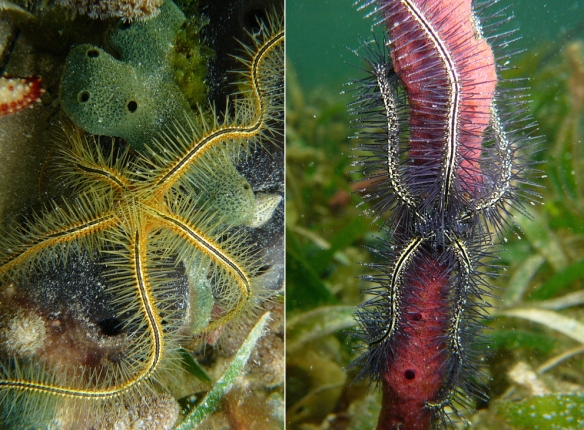
The brittle star Ophiothrix suensonii is highly variable in color, wraps itself around many different species of sponge, and is very common in Bocas.
Photo by Ryan Ellingson

The caribbean reef octopus Octopus briareus. Click here to see it change shape and color as it retreats from me into mangrove roots.
Photo and video by Ryan Ellingson.

Ascidians just hang out and filter feed like sponges, but are very far away on the tree of life – despite their apparently simple morphology they are actually more closely related to vertebrates than any other marine invertebrate. This species is Polycarpa spongiabilis.
Photo by Ryan Ellingson

The spotted cleaner shrimp Periclimenes yucatanicus lives among anemone tentacles. It’s a type of cleaner shrimp that waves its antennae to attract fish so that it can eat algae, parasites and dead tissue from the fish’s body.
Photo by Ryan Ellingson


